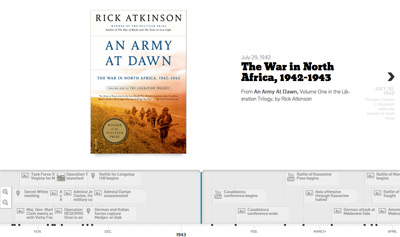Historical Documents from The Liberation Trilogy
An Army at Dawn
The images in this slideshow are scans of the original documents. The chapter numbers indicate where, in An Army at Dawn, the document is relevant.
The following documents are included in this slideshow:
- Message from Gen. George C. Marshall to Lt. Gen. Dwight D. Eisenhower on Oct. 5, 1942, regarding Operation TORCH battle plans in Morocco. National Archives. (Prologue)
- Message from Marshall to Eisenhower regarding rules of engagement in fighting Vichy French forces in Operation TORCH. National Archives. (Chapter 1)
- Post-war letter regarding Operation RESERVIST from Maj. Gen. Lyman L. Lemnitzer to Brig. Gen. Paul Robinett, who at the time was assigned to the Army’s military history office. National Archives. (Chapter 2)
- Initial pages of Lt. Gen. Mark W. Clark’s official 1943 account of his armistice negotiations with French officials. National Archives. (Chapter 3)
- Lt. Gen. Kenneth A.N. Anderson’s letter to Eisenhower (“My dear C-in-C”) regarding the failed attack at Tébourba in northern Tunisia, in early December 1943. In his handwritten postscript, Anderson apologizes for seeming “rather pessimistic.” Dwight D. Eisenhower Presidential Library. (Chapter 5)
- Anderson’s letter to Eisenhower on Jan. 1, 1943, a week after failed attempt to take Longstop Hill. Eisenhower Library. (Chapter 6)
- Maj. Gen. George S. Patton’s memo to Eisenhower on Jan. 2, 1943, regarding French theories on the assassination of Adm. Darlan. Eisenhower Library. (Chapter 6)
- Minutes of Jan. 16, 1943 meeting between President Roosevelt and his senior military officers at Casablanca. Marshall discloses to the president that an invasion of Sicily, Operation HUSKY, seems likely as the next Allied move after the North African campaign. National Archives. (Chapter 7)
- Memo to Eisenhower from Truscott, Jan. 23, 1943, regarding deficiencies of French troops deployed in Tunisia. George C. Marshall Library. (Chapter 8)
- Memo to Eisenhower from Truscott, Feb. 12, 1943, on the eve of the German attack toward Kasserine Pass, asserting that “in one respect only have Axis forces demonstrated superiority.” George C. Marshall Library. (Chapter 8)
- Letter from Eisenhower to Fredendall in early February 1943, voicing concern about “the habit of some of our generals in staying too close to their command posts.” Fredendall read selected portions of this letter to Ward. Eisenhower Library. (Chapter 8)
- Eisenhower message to Maj. Gen. Omar Bradley on Apr. 16, 1943, regarding the impending assault on the final Axis bridgehead around Tunis and Bizerte. Eisenhower’s reference to “quite severe criticism” of the 1st Armored and 34th Infantry Divisions is an allusion to the units’ spotty performance at Maknassy and Fondouk, respectively. U.S. Army Military History Institute. (Chapter 12)
The Day of Battle
The images in this slideshow are scans of the original documents. The chapter numbers indicate where, in The Day of Battle, the document is relevant.
The following documents are included in this slideshow:
- An Oct. 1943 memorandum from an Army prosecutor to Maj. Gen. Troy Middleton, commander of the 45th Infantry Division, recommending that a company commander, Capt. John T. Compton, be court-martialed for murder in the massacre of thirty-six Italian prisoners outside Biscari, Sicily, on July 14, 1943. (Chapter 2)
- An Oct. 1943 memo by Brig. Gen. John W. O’Daniel, who later commanded the 3rd Infantry Division at Anzio, about the role of the 36th Infantry Division in the amphibious assault at Salerno. This document, from the Citadel Archives and Museum in Charleston, S.C., contains the handwritten notations of Lt. Gen. Mark W. Clark, commander of Fifth Army, on the cover sheet. (Chapter 4)
- A June 1944 memo to Maj. Gen. Lucian Truscott, commander of the U.S. Army’s VI Corps, describing the confusion in getting the corps headquarters ashore during the invasion at Salerno in Sept. 1943, when the corps was commanded by Maj. Gen. Ernest Dawley. (Chapter 4)
The Guns at Last Light
The images in this slideshow are scans of the original documents retrieved by Rick Atkinson during his research for The Guns at Last Light.
The following documents are included in this slideshow:
- A letter from Maj. Gen. R.O. “Tubby” Barton, dated 13 July 1944, to Eleanor Roosevelt, describing the circumstances of Brig. Gen. Theodore Roosevelt’s death in Normandy that day.
- A note from Lt. Gen. Walter Bedell “Beetle” Smith, dated Oct. 31, 1946, to Maj. Gen. A.D. Bruce, explaining his unusual nickname, which he says supplants his original nickname, “Fishface.”
- An undated statement from Brig. Gen. Doyle O. Hickey recounting the death of Maj. Gen. Maurice Rose, commander of the 3rd Armored Division, on 30 March 1945.
- Correspondence in March 1945 from the Dwight D. Eisenhower Presidential Library between Eisenhower and Maj. Gen. Maurice Rose about the quality of Sherman tanks compared to German Panther tanks. Eisenhower displays a superficial knowledge on this subject less than two months before the end of the war (and two weeks before Rose’s death). Rose also comments on other equipment in the American inventory.
- Transcript of a telephone conversation on 16 Sept. 1944, between Lt. Gen. Alexander M. Patch and Maj. Gen. Lucian K. Truscott, Jr., about the latter’s distress over the American high command’s reluctance to immediately capture the Belfort Gap and Alsace.
- Correspondence between Gen. Dwight D. Eisenhower and Lt. Gen. George S. Patton, Jr., over the latter’s proposal to provide French brothels with penicillin. The supreme commander disapproves.
- A secret memo to Secretary of War Henry Stimson, dated 18 July 1944, from Robert A. Lovett, assistant secretary of war for air, regarding self-sealing gasoline tanks on troop carrying aircraft. Other documents on this subject include a letter to Stimson, dated 1 June 1944, from Lt. Col. David N. Laux, regarding what he says as poor policy decisions. This issue will arise again with a vengeance during Operation VARSITY PLUNDER in March 1945.
- A sketch map, presumably drawn by a U.S. Army engineer in March 1945, of the captured bridge over the Rhine at Remagen, Germany.







